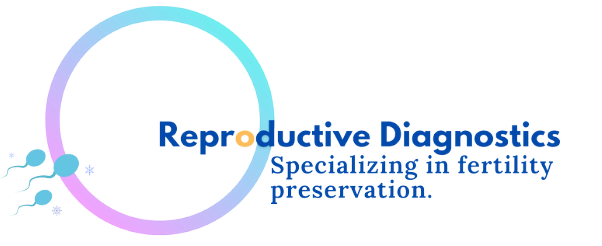It is important to take an active role in your fertility treatment and/ or fertility preservation. Understanding the processes and tests your doctor is recommending is key. We hope you find this Glossary helpful and encourage you to ask questions and familiarize yourself with the concepts. You are your own patient advocate and will be most satisfied with your treatment plan when you know the basis of recommendations being offered.
Following is a glossary of terms commonly used in the field of fertility.
A
Activity: A rating (on a scale of 0-4) of the swimming speed of sperm cells in conjunction with the ability to swim in a straight direction.
Agglutination: Adherence of sperm cells to other sperm cells creating aggregates of sperm cells (>4 sperm cells adhering to one another is considered agglutinated). Agglutination can interfere with the sperm’s ability to swim.
Andrology: The study of male fertility/ infertility.
Antibody Test: An andrology test that detects the presence of antibodies on the surface of sperm in males or in the bloodstream of females. The antibodies may interfere with the sperm’s ability to swim and/or penetrate an egg. Testing is performed using immunobead or Mixed Agglutination Reaction (MAR) procedures.
Artificial Insemination: A procedure performed under a physician’s direction whereby a prepared semen sample is placed into the uterus or cervix in an attempt to establish a pregnancy. Most commonly, semen from a woman’s sexually active partner or donor semen is used.
Azoospermia: No sperm in the ejaculate.
C
Client Depositor: A male who freezes sperm or a female who freezes oocytes (eggs) for his/ her own use in the future. A client depositor is not a donor.
Cryopreservation: The act of freezing and thawing.
Cryoprotectant: An additive which enhances the survival rate of the cells during cryopreservation. The most common cryoprotectant added to human semen is glycerol. Propandiol is commonly used in slow rate human embryo freezing.
Cryoprotectant Buffer: An additive to a processed semen sample which enhances the cell’s ability to survive cryopreservation. The buffer “coats” the cells and protects them during cryopreservation and also acts as an energy source for the cells.
D
Density: The number of sperm cells, motile and nonmotile, present in a semen sample. Density can be expressed as the total number of sperm in the semen sample or as a number of sperm per milliliter of semen sample.
Density Gradient: A colloidal or silica particle suspension used during centrifugation to separate motile sperm cells and normal morphological forms from round cells, cellular debris, seminal fluid, and abnormal morphological forms.
Directed Donor: A reproductive donor who is known to the recipient and who directs his semen or her eggs for use by that particular recipient.
E
Egg: The female gamete. Oocyte.
Ejaculate: Seminal fluid from the accessory sex glands of the male with the sperm cells suspended within. Another term for ejaculate is semen.
Embryo: The result of a sperm cell fertilizing a mature egg. The embryo will progress through cell divisions from one cell to two cells, from two to four cells, from four to eight cells, and so on. Terminology changes once the embryo implants into the uterine wall and a pregnancy is established.
F
Forward Progression: straight, directional, swimming motion of sperm cells.
Fructose: a product of the seminal vesicles that provides energy for sperm. The absence of fructose in semen can indicate absence or obstruction of the vas deferens and/or seminal vesicles.
G
Gamete: The egg or the sperm. Both require union with the other before subsequent embryos can form.
Grading: As in embryo grading. A subjective evaluation of the appearance of an embryo. Grading is based on the amount of fragmentation within the embryo, the shape of the cells, and the presence of certain visible structures within the embryo. Grading is purely subjective and not necessarily indicative of the embryo’s ability to establish a pregnancy. See Photo Gallery on Home Page for a schematic of embryo grades.
I
Intra-Cervical Insemination (ICI): A procedure whereby a semen sample is deposited at the base of the cervix in an attempt to establish a pregnancy. The premise is that sperm cells will swim through the cervix and into the uterus and Fallopian tubes. Specimens containing seminal fluid can be inseminated intra- cervically because the cervix acts as a natural filter, removing the seminal fluid, which is seen as foreign to the uterine environment.
Intra-Uterine Insemination (IUI): A procedure whereby a processed semen sample is deposited directly into the uterus in an attempt to establish a pregnancy. Specimens used for IUI cannot contain seminal fluid and therefore must undergo a wash process to remove it either prior to cryopreservation or prior to the insemination.
L
Liquefaction: The normal enzymatic breakdown of the gelatinous phase of the semen sample. The portion of the semen sample which does not break down in approximately 30 minutes to a pure liquid form is termed non-liquefaction. Some non-liquefaction is considered clinically insignificant and the amount in each sample can vary individual to individual.
Liquid nitrogen: The environment in which cryopreserved specimens (sperm, eggs, and embryos) are stored and shipped. The liquid phase of nitrogen is -196°C. Cryopreserved specimens are stored at this temperature in the laboratory. The vapor phase of nitrogen has a slightly higher temperature. Shipping tanks used to deliver specimens maintain vapor temperature and the vapor phase facilitates shipping.
M
Morphology: An andrology test in which sperm cells are evaluated based on the physical appearance (size and shape) of each cell.
Motility: Any movement or motion exhibited by sperm cells. Motility is not necessarily forward progression.
O
Oligozoospermia: Reduced number of sperm in the ejaculate (usually less than 10 million/ml).
Oocyte: The female gamete. Egg.
R
Round Cells: White blood cells (leukocytes) and immature spermatozoa that cannot be differentiated between during a routine semen analysis.
S
Semen: Ejaculate containing sperm cells and seminal fluid from accessory sex glands.
Semen Analysis: An evaluation of a semen sample that includes the density of sperm cells, percent motility, activity, and other parameters.
Seminal Fluid: Semen without the sperm cells. The fluid from accessory sex glands helps transport the sperm cells through the reproductive tract and provides some support to sperm cells. Seminal fluid is removed prior to intra-uterine inseminations and most other ART procedures.
Sperm: The male gamete.
Sperm Cryopreservation: Also known as “Sperm Banking,” is the freezing of a semen specimen in liquid nitrogen to a temperature of -196º Celsius and its subsequent storage at that temperature until used in the future.
Sperm Wash: A process used to concentrate and separate motile sperm cells in a semen sample from seminal fluid and nonmotile sperm cells.
T
Therapeutic Donor Insemination (TDI): Insemination with a donor sperm sample for the purpose of conceiving a child. The donor can be an anonymous or directed donor.
V
Viability Analysis: An andrology test that determines whether a sperm cell is viable (alive).
Viscosity:An evaluation of the consistency of a semen sample (i.e. the degree of difficulty in which the semen sample can be drawn into and expelled from a pipette). Normal viscosity is discreet droplets.
Vitrification:Similar to cryopreservation, but an alternative method of preserving reproductive cells for future use. High concentrations of cryoprotectant are added to the cells which are then “flash frozen” and preserved.
Volume: The amount of a semen sample, measured in milliliters.


